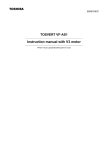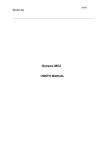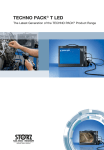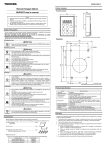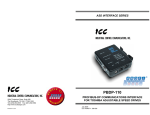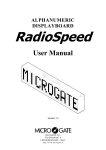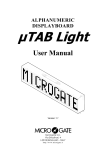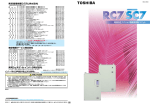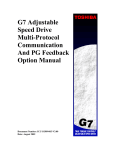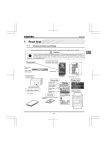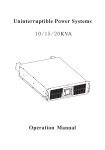Download VFA7 with V3-motor
Transcript
E6581305 TOSVERT VF-A7 Instruction manual with V3 motor VFA7+Vector option[VEC001Z,003Z] with V3 motor Technical information described in this document is used to explain typical operations and applications of products, and this is not intended to grant warranty or licensing right on it s use regarding TOSHIBA group or a third party intellectual property and other right. © Toshiba Schneider Inverter Corporation 2004 All rights reserved. E6581305 - Contents 1. Comparison with VF-V3 (VFA7+PG feedback).........................................................................................................................2 2. Combination with the motor only for VFV3 ...............................................................................................................................7 2.1 Parameter setting................................................................................................................................................................8 2.2 Standard connection for VFA7 and V3 motor (1) ..............................................................................................................10 2.3 Standard connection for VFA7 and V3 motor (2) .............................................................................................................. 11 2.4 Modify of optional cable (RAD320-CA1) ...........................................................................................................................12 2.5 Sensor cable (CAB010) for VEC001Z and V3 motor ........................................................................................................13 3. Appendix.................................................................................................................................................................................14 3.1 Setting the rating of the motor...........................................................................................................................................14 3.2 Explanation of motor parameter........................................................................................................................................15 3.3 Default setting of motor parameter....................................................................................................................................16 3.4 Accuracy of torque control ................................................................................................................................................17 3.5 Notes on the vector control ...............................................................................................................................................18 1 E6581305 1. Comparison with VF-V3 (VFA7+PG feedback) [Specifications, functions] Series name Output capacity Overload rating Control method Control function 200V input class Main power supply 400V input class Rated Speed Maximum motor speed Maximum output frequency Speed control range Speed rate of Speed change control Speed instruction input TOSVERT-VFA7+PG feedback option 200V: 0,4~90kW 400V: 0.75~280kW 200V: ~55kW, 400V: ~75kW 150%~120sec, 215%-0.5sec 200V 75kW~, 400V: 110kW~ 150%-60sec, 180%-0.3sec PWM control [Vector control, Digital current control for all range] Speed/ Torque/ Positioning 3ph-200~230V-50/60Hz *only 11~55kW 3ph-200~220V-50Hz 3ph-200~230V-60Hz 3ph-380~460V-50/60Hz *only 30~75kW 3ph-380~440V-50Hz 3ph-380~460V-60Hz 60HZ / 1800min-1 (4 pole) *1 80Hz / 2400min-1 (4 pole) *1 80Hz *2 1:1000 Digital setting: +/-0.01% Analog setting: +/-0.1% 0-+10Vdc / Maximum speed 0-+10Vdc / Maximum speed 4-20mAdc / Maximum speed input Forward pulse / reverse pulse sequence Kind of pulse Positioni Maximum 160kpps ng frequency control Electronic gear 100 ~ 400 ppr / 1 rotation setup Torque control / Torque 0-+/-10Vdc operation input TOSVERT VF-V3 200V: 2.2~55kW 150%-60sec, 200%-2sec (up to 11kW) PWM control [Vector control, Digital current control for all range] Speed/ Torque/ Positioning 3ph- 200~220V-50/60Hz 1500min-1 2400min-1 80Hz 1:1000 Digital setting: +/-0.01% Analog setting: +/-0.1% 0-+/-10Vdc / Maximum speed (Possible to adjust internal setting) Forward pulse / reverse pulse sequence 160kpps 100 ~ 400 ppr / 1 rotation 0-+/-10Vdc 2 E6581305 Control function Acceleration/ Deceleration time setting Switching control mode Preset speed Braking method Torque limit(Current limiting function) 0.1-6000sec(Straight/ S character) 0.0-60.0sec(Straight/ S character) Possible to switch Possible to switch 15 preset speed maximum Dynamic brake(resistor) or Re-generating to power supply * Resistor is option devices over 5.5kW * Regenerating converter: SB3 or RC7 Possible to adjust internal setting or external signal. Without temperature compensation Electronic gear(for positioning control) Enabled to use torque limit function Before the past 4 times 100 or less times of a motor GD2 2.2 ~ 15kHz (200V ~55kW, 400V~75kW) 2.2 ~ 5kHz (200V 75kW~, 400V 110kW~) Low speed detection Reach fixed speed/ finished positioning 3 preset speed Dynamic brake(resistor) or Re-generating to power supply * Resistor is option devices over 22kW * Regenerating converter: SB3 or RC7 Possible to adjust internal setting or external signal. With temperature compensation Electronic gear(for positioning control) Enabled Before the past 8 times 20 or less times of a motor GD2 up to 11kW: 8kHz fixed over 15kW: 2kHz fixed Low speed detection Reach fixed speed/ finished positioning Contact output signal Speed limit Snap stop control Trip history monitor Applied load GD2 PWM carrier frequency Low speed detection Reach fixed speed/ finished positioning Standby Standby Current limiting Over torque alarm Fault Fault (All trip code or without EF, OCL trip) [1c relay output, open collector output] Fault code Positioning/ feed back output Fault code (2 bit + 4(option) bit) Speed Encoder signal with option pulse (A, B phase: 1000ppr, Z phase: 1ppr) *1 Depends on Motor design and setting of carrier frequency *2 Possible control up to 120Hz with vector control with specific motor (Possible control 400Hz with V/f control.) 3 Standby Current limiting Fault (All trip code) [Open collector output] OFF: Fault ON: Normal Fault code(4 bit Encoder signal (A, B phase: 1000ppr, Z phase: 1ppr) E6581305 Series name Analog output Adjust method Monitor Monitoring function TOSVERT-VFA7 + PG feedback option TOSVERT-VFV3 2 output circuit(0-10V) + 2 output by 2 output(+/-10V) option(+/-10V, 0-20mA) (Speed/ torque or Torque / output current) (Select from 31 functions) 6 touch key operation with operation panel 7 segment LED - Frequency of trip - Output current of peek - Status - Out put voltage of peek - Output frequency - Dc-Bus voltage of peek - Operation frequency - PG value like motor - Output current counter - DC-bus voltage - Positioning pulse - Output voltage - RR input - Actual output frequency - VI/II input - Speed feedback value(real - RX input time) - RX2 input - Speed feedback(1sec - FM output filtering) - AM output - Torque - Fixed output level for - Operation torque meter adjustment - Internal torque - Information of input - Excitation current terminals - PID feedback value - Information of output - Percentage of motor over terminals load - Switching condition of - Percentage of inverter SINK/SOURCE over load - Kind of connected - Percentage of PBR over optional devices load - CPU version - Percentage of PBR load - FLASH memory - Input power version - Output power - EEPROM1(for control PCB) version - EEPROM2(For drive PCB) version - Trip history 1-4 - Accumulation operation t ime 4 5 touch key operation + 1 reset switch 7 segment LED - Standby ON/OFF indication - Operation speed - Speed - Torque - Information of input terminal - History of trip E6581305 Protection Over current while acceleration Over current while deceleration Over current while constant speed Over current when starting U-arm over current V-arm over current W-arm over current Input phase failure Output phase failure Over voltage while acceleration Over voltage while deceleration Over voltage while constant speed Over load for inverter Over load for motor Over heat Emergency stop Failure of EEPROM PBR over current PBR over load Failure of CPU Failure of communication command Failure of Gate-array Failure of SINK/SOURCE switching Failure of operation keys Communication RS485 standard OPTIONAL devices: RS232C, S20, F10M Standard CE, UL SINK/ SOURCE Enabled switching - - - - Failure of current detection circuit Failre of optional devices Failure of FLASH memory Low output current Low input voltage(Main power/ Control power) Over torque Earth failt Failure of DC-Bus fuse Failure of auto-tuning Failure of inverter’s type-form Failure of initialize Failure of RAM Failure of ROM - Over Current Over voltage Low input voltage Over load Over heat/ Failure of regeneration Failure of sensor Over speed Over Position deviation Motor restraint Over travel Failure of parameter setting RS232C, RS485 with Optional device “P CU10(card for positioning)” none none 5 E6581305 [Comparison of characteristics] Series Control method Vector control with sensor TOSVERT-VFA7 + PG feedback option TOSVERT-VFV3 Current vector control Current vector control PG feedback (*1), Without temperature PG feedback with temperature sensor sensor up to 11kW: 0Hz-200% Starting torque 0Hz-200% Sensor-less: 0.5Hz-200% over 15kW: 0Hz-150% Power running Enable Enable Zero speed torque Regenerating Enable (Disable when sensor-less) Enable Speed presumption system Slip frequency presumption from torque Slip frequency presumption from torque current current 1:1000 (only PG feedback) 1:1000 Speed control range Sensor-less 1:150 *2 Speed control accuracy +/-0.02% *3 +/-0.01% (only PG feedback) (Digital setting) Sensor-less +/-0.5% *4 ~ 40 rad/s 60rad/s Speed response Sensor-less 15~20rad/s 1000ppr 1000oor Line drive system(5V) or Line drive system(5V) PG specifications Complementary(12V) 40kHz(60kHz) of maximum input 60kHz of maximum input pulse pulse frequency frequency Enable without temperature compensation Enable Torque control Torque control range (Torque -100~100% -100~100% value) Speed response while torque All range All range control +/-10% +/-10% Accuracy of torque control (When motor temperature is hot.) (With motor temperature detection) Speed range of torque 1:20 1:5 1:2 Sensor control Power -less +/-30% +/-20% +/-10% Accuracy running control of torque Regenerating +/-30% +/-20% Power All range (Sensor-less 1:20) All range Speed range of running torque limit Regenerating All range (Sensor-less 1:5) Enable Enable only speed or torque control Auto-restart Regenerative power ride-though Enabled none control *1 VF-A7: The inverter’s capacity is larger than motor’s (1 rank-up) *2 VF-A7: This is over 3.7kW of inverter and motor capacity. (Depends on rated slip frequency) *3 VF-A7: The base frequency is 60Hz setting. *4 VF-A7: About 10% of rated slip 6 E6581305 2. Combination with the motor only for VFV3 The VF-A7 is possible to operate V3 motor with next optional devices. [Speed control, Torque control, Positioning control] Vector control option with sensor (Multi-function): VEC001Z [Speed control, Torque control] Vector control option with sensor (Line driver output): VEC003Z [NOTICE] - The VF-A7’s capacity is larger than V3 motor’s. (1 rank or 2 rank-up) - To install dynamic braking resistor(option) when the machine need large regenerative torque. It is necessary to install large capacity of resistor in next condition. 1. Short time cycle of acceleration and deceleration 2. Large load inertia - The VEC002Z can’t use for V3 motor which PG specifications is line driver output.. [Table of VFA7 and V3 motor combination] Output Case capacity V3 motor’s type-form number (kW) 2.2 IK-EBKM8-VFV3 100L 3.7 IK-EBKM8-VFV3 112M 5.5 IKK-EBKM8-VFV3 132S 7.5 IKK-EBKM8-VFV3 132M 11 IKK-EBKM8-VFV3 160M 15 IKK-EBKM8-VFV3 160L 22 TIK-EBKM8-VFV3 180M 30 TIK-EBKM8-VFV3 180L 37 TIK-EBKM8-VFV3 200L 45 TIK-EBKM8-VFV3 200L 55 TIK-EBKM8-VFV3 225S *1 The type-form of V3 motor is Leg attachment type. VFA7 specifications VFA7-2037PL VFA7-2055PL VFA7-2075PL VFA7-2110P VFA7-2150P VFA7-2185P VFA7-2300P VFA7-2370P1 VFA7-2450P1 *2 VFA7-2550P1 *2 VFA7-2750P1 *2 Load reduction may be needed. VFA7 specifications: Overload rating: 150%-2min, 215%-0.5sec VFV3 specifications: Overload rating: 150%-2min, 215%-0.5sec The starting torque is 200%~300%. 7 VFV3 specifications VFA7-2055PL VFA7-2075PL VFA7-2110P VFA7-2150P VFA7-2185P VFA7-2220P VFA7-2370P1 VFA7-2450P1 VFA7-2550P1 VFA7-2750P1 VFA7-2900P1 E6581305 2.1 Parameter setting To use VFA7 with V3 motor, these parameter setting are needed. * It is necessary to set others parameter for torque control or positioning control Title vL Pt OLM F240 F304 F306 Function Base frequency Selection of V/f control Selection of electric thermal characteristics Starting frequency Selection of Dynamic brake Base frequency voltage 1 Setting range 25.0 – 400.0 Hz 0–9 0–7 F308 0.0 – 10.0 Hz 0: Disabled , 1: Enabled 0 – 600 V 0: Without power supply voltage compensation Without output voltage limit 1: With power supply voltage compensation Selection of base frequency Without output voltage limit 2: Without power supply voltage voltage compensation With output voltage limit 3: With power supply voltage compensation With output voltage limit PBR value 1.0 – 1000 ohm F309 PBR capacity 0.01 – 600 kW F367 Pulse number of PG input 1 – 9999 F400 Selection of auto-tuning 0 –2 F412 Motor rated capacity 0.10 – [depends on capacity] F413 Motor type 0 –4 F606 OL reduction frequency F307 starting 0.0 – 30.0 Hz *1 It is necessary to set when use braking resistor. *2 Set the using V3 motor’s rated capacity. 8 Setting value 52 8 or 9 4 0.0 1 *1 160 1 Depends on capacity *1 Depends on capacity *1 1000 1 (Initialize of motor parameter) *2 2 (V3 motor) 0.0 E6581305 Parameters of individual adjustment Title F374 F375 Function Current control proportional gain Current control integral gain NOTE It is necessary to adjust torque response in torque control mode. * Usually, not to change (default setting) Depends on inverter’s capacity and load inertia. Please adjust next formula. F376 = (50 + A * PW) * J0.12 F376 Speed loop proportional gain F377 Speed gain loop integral A: Coefficient of motor pole (2 pole: 1.8, 4 pole: 2.0, 6 pole: 2.2) PW: Inverter’s capacity (ex. VFA7-2037PL: PW=3.7) J: Load inertia / Toshiba standard motor’s inertia (ex. 4 times of inertia: J=4) Usually, not to change (default setting). 9 E6581305 2.2 Standard connection for VFA7 and V3 motor (1) This connection diagram is for VFA7 and VEC001Z(Vector control option with sensor). When you select torque control or positioning control, it is necessary to wire others connection. MCCB THR Noise filter (OPTION) AC reactor DC reactor Braking resistor (OPTION) (OPTION) (OPTION) MCCB MC Power PA P0 FU FV FW PA PB FAN R/L1 U/T1 S/L2 V/T2 U V MOT W T/L3 R0 W/T3 VEC001Z S0 Note 1 [Power Supply] UP to 7.5kW: 3ph-200~230V-50/60Hz Over 11kW: 3ph-200~220V-50Hz 3ph-200~230V-60Hz Stand-by ST Forward F Reverse R CC CN8-6 CN8-5 CN8-12 CN8-11 CN8-14 CN8-13 CN8-10 CN8-7 CN8-16 CN8-15 CN8-8 F E K J M L H G P N SENSOR Encoder E VFA7 Note 2 Note1 Over 30kW, it is necessary to connect control power supply. Note2 To need modify CN8 connection when using V3 motor cable (RAD320-CA1) V3 motor To use CAB010(OPTION), Not to need modify Note3 The detail explanation for VEC001Z, please refer attached user’s manual for VEC001Z. [Table of wiring for V3 motor’s sensor cable] CN8 Canon plug Wire color(*) V3 signal name CN8 terminal’s signal name CN8 Canon plug Wire color(*) 1 A BW PGA1 9 2 B BW/WT PGA2 10 H BL 3 C RD PGB1 11 J YL 4 D RD/WT PGB2 12 K BL/WT 5 E OG MT PGZ1 13 L GR 6 F OG/WT MT PGZ2 14 M GR/WT 7 G BL/WT NZ NZ 15 N GY 8 SHLD E terminal 16 P GL/WT BW: Brown, WT: White, RD: Red, OG: Orange, BL: Blue, YL: Yellow, GR: Green, GY: Gray * There are case of different from wiring color. 10 V3 signal name V3 signal name Z NA A NB B COM P5 VD Z NA A NB B PGCC PGVC E E6581305 2.3 Standard connection for VFA7 and V3 motor (2) This connection diagram is for VFA7 and VEC003 (Vector control option with sensor). When you select torque control or positioning control, it is necessary to wire others connection. MCCB THR Noise filter (OPTION) AC reactor DC- reactor Braking resistor (OPTION) (OPTION) (OPTION) MCCB PA P0 MC Power FU FV FW PA PB FAN R/L1 U/T1 S/L2 V/T2 U V MOT W T/L3 R0 W/T2 S0 [Power Supply] A NA B NB Z NZ PGVC PGCC E Note 1 UP to 7.5kW: 3ph-200~230V-50/60Hz Over 11kW: 3ph-200~220V-50Hz 3ph-200~230V-60Hz Stand-by ST Forward F Reverse R F E K J M L H G P N VEC003Z CC SENSOR Encoder E VFA7 V3 motor Note 2 Note1 Over 30kW, it is necessary to connect control power supply. Note2 To need modify CN8 connection when using V3 motor cable (RAD320-CA1) To use CAB010(OPTION), Not to need modify Note3 The detail explanation for VEC003Z, please refer attached user’s manual for VEC003Z. [Table of modify for V3 motor’s sensor cable] CN8 Canon plug Wiring color Signal name 1 2 3 4 5 6 7 A B C D E F G BW BW/WT RD RD/WT OR OR/WT BL/WT MT MT NZ 8 - - SHLD NOTE CN8 Canon plug Wiring color Signal name NOTE not to use not to use not to use not to use not to use not to use Connect to NZ 9 10 11 12 13 14 15 H J K L M N BL YL YL/WT GR GR/WT GY Z NA A NB B COM Connect to E 16 P GY/WT P5 not to use Connect to Z Connect to NA Connect to A Connect to NB Connect to B Connect to PGCC Connect to PGVC BW: Brown, WT: White, RD: Red, OG: Orange, BL: Blue, YL: Yellow, GR: Green, GY: Gray * There are case of different from wiring color. 11 E E6581305 2.4 Modify of optional cable (RAD320-CA1) When using sensor cable “RAD320-CA1” for VF-V3 made by Toshiba Industrial Products Corporation, cut the shield of CN8-8pin side and connect to ground(E terminal). Manufacturing In case of using CAB010 (OPTION), this modify don’t need. V3 motor side SideVEC001Z Sensor plug CN8 Inverter Remove screw CN8 Canon plug RAD320-CA1 modify method 1. Remove screw of CN8 CN8 connector-pin assignment 2. Cut 8 pin(SHLD) 11 12 13 14 A A B B 1 Cut 8 pin 7 8 Z SHLD 2 9 15 16 COM P5 10 X 3 4 5 6 MT MT View: Soldering side of connector 3. Connect 8-pin(shield line)ground/earth terminal of VEC001Z. 4. Repair CN8 after taping (insulation) 12 E6581305 2.5 Sensor cable (CAB010) for VEC001Z and V3 motor The CAB010 has three variety for cable length. Type-Form CAB010-10M CAB010-20M CAB010-30M Cable length(L) 10m 20m 30m Connect to motor case (M5) Connect E terminal of VEC001Z (M3) 13 E6581305 3. Appendix 3.1 Setting the rating of the motor Check the motor for use. (pole number, rating capacity, type) Motor type: H Number of motor poles: H Adjustment range/,,,,,,, Adjustment range/ : Toshiba standard motor #1 : Toshiba VF motor : Toshiba V3 motor : Toshiba standard motor #2 : Other motors Rated capacity of motor: H Adjustment range/~ [kW] : : : : Toshiba Toshiba Toshiba Toshiba standard motor #1 VF motor V3 motor standard motor #2 Motor Pole Other than 4P motor type: : Other motors number: Is motor capacity same with Inverter capacity? 4P motor Set H (Rated capacity) Setting/~ [kW] Yes No Set H (Rated capacity) Setting/~ [kW] Set H (Motor type) Setting/~ Setting/ Set H (Motor type) Setting/ End of tuning Set H (Auto-tuning) Set H (Auto-tuning) Set H (Motor type) Setting/ Setting/ <Caution> In case "GVP" (Tuning error) is displayed at the time of power injection, set H at . Set H (Auto-tuning) Setting/ In case desirable property doesn't appear. Set H (Number of motor poles) Setting/,,,,,,, Give a Run command End of auto-tuning No trip →Panel displays "CVP" →Run (at least 30Hz) 14 Tuning error (GVP) appeared Manual tuning Set motor constant parameters manually. E6581305 3.2 Explanation of motor parameter This section describes how to set motor constants. Select the items to be improved and change the related motor constants. 1. Slip frequency gain H This parameter is to adjust the slippage of the motor. Setting this parameter at a larger number can reduce the slippage of the motor. However, setting it at an excessively large number may result in hunting, etc., and thus cause an unstable operation. 2. Motor constant #1 H(Primary resistance) (Motor test reports may be useful.) This parameter is to adjust the primary resistance of the motor. Setting this parameter at a larger value can prevent the drop of the motor torque in low speed ranges due to a voltage drop. However, setting it at an excessively large number may result in large current in low speed range and appearance of overload trip, etc.. 3. Motor constant #2 H(Secondary resistance) This parameter is to adjust the secondary resistance of the motor. The larger the set value, the more the slippage of the motor can be compensated. 4. Motor constant #3 H(Exciting inductance) (A motor test record can be used for this setting.) This parameter is to adjust the exciting inductance of the motor. The larger the set value, the more the no-load current can be decreased. 5. Motor constant #4 H(Load inertia moment) This parameter is to adjust the transient response of the motor. Setting this parameter at a larger value can reduce overshooting on completion of acceleration or deceleration. Set this parameter at a value, which matches to the effective moment of inertial. 6. Motor constant #5 H(Leak inductance) (Motor test reports may be useful.) This parameter is to adjust the leakage inductance of the motor. The larger the set value, the larger torque the motor can be produced in high-speed ranges. 15 E6581305 3.3 Default setting of motor parameter Motor Motor Motor Motor constant #1 constant #2 constant #3 constant #5 (primary (secondary (exciting (leak nverter model resistance) resistance) inductance) inductance) H VFA7-2004PL VFA7-2007PL VFA7-2015PL VFA7-2022PL VFA7-2037PL VFA7-2055PL VFA7-2075PL VFA7-2110P VFA7-2150P VFA7-2185P VFA7-2220P VFA7-2300P VFA7-2370P1 VFA7-2450P1 VFA7-2550P1 VFA7-2750P1 VFA7-2900P1 VFA7-4007PL (*1) VFA7-4015PL VFA7-4022PL VFA7-4037PL VFA7-4055PL VFA7-4075PL VFA7-4110PL VFA7-4150PL VFA7-4185P VFA7-4220P VFA7-4300P VFA7-4370P1 VFA7-4450P1 VFA7-4550P1 VFA7-4750P1 VFA7-4110KP1 VFA7-4132KP1 VFA7-4160KP1 VFA7-4220KP1 VFA7-4280KP1 H H H (*1): and G blink alternately because the setting value is larger than 10ohm(10000mohm). (*2): For each inverter model, H's upper limit is rated capacity of one rank larger inverter. (Example: For the model VFA7-2004PL, the upper limit is 0.75) 16 E6581305 3.4 Accuracy of torque control - Sensor-less vector control. (Inverter’s capacity is same as motor’s.) Control range 1:20 100% Torque +/-30% (+/-10%) over 30% +/-20% (+/-10%) +/-10% (+/-5%) +/-30% (+/-10%) 0 90 (+/-30%) 360 Over +/-30% 900 1800 +/-30% (+/-10%) +/-20% (+/-10%) -1 Speed[min ] +/-30% (+/-10%) +/-30% -100% Control range 1:5 0.4Hz - Vector control with sensor. (Inverter’s capacity is same as motor’s.) Torque 100% In with a standard motor + sensor, continuation operation cannot be performed in this domain. 70% 50% +/-10% +/-10% Speed 10% 0 100% 5% Base frequency +/-10% -50% The highest permission operation frequency +/-10% -70% -100% 17 E6581305 3.5 Notes on the vector control 1) The vector control fully exerts its effect in frequency ranges below the base frequency (WN) and its effect is reduced in frequency ranges above the base frequency. 2) Set the base frequency between 40 and 120 Hz when selecting a sensor-less vector control mode (RV=~, ), or between 25 and 120 Hz when selecting a sensor vector control mode (RV=, ). 3) Use a general-purpose or squirrel-cage motor with the same rating as the inverter, or smaller by one rank. This inverter cannot be used for motors with capacities of less than 0.4 kW. If the VFA7-2004PL is combined with a 0.2 kW motor, an auto-tuning error (GVP) may arise, and thus disable the vector control. 4) Use a motor with 2 to 16 poles. 5) Use the inverter for a single motor at a time. This inverter is incapable of vector -controlling more than one motor simultaneously. 6) Do not use wires longer than 30 m for the connection between the inverter and the motor. When using wires longer than 30 m, select a normal auto-tuning mode to improve the low-speed torque characteristics in vector control mode. In this case, the torque produced by the motor decreases more or less around the rated frequency because of a voltage drop. 7) If a reactor or surge suppressing filter is connected between the inverter and the motor, the torque produced by the motor may decreases or the inverter may trip (GVP) in auto-tuning mode, and therefore the vector control can not be used. 8) Connect speed sensor for vector control with sensor to the motor. Connecting via gear, etc. causes motor’s oscillating or inverter’s trip by lack of rigidity. 18



















